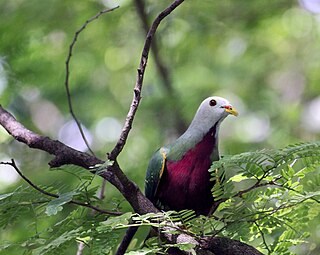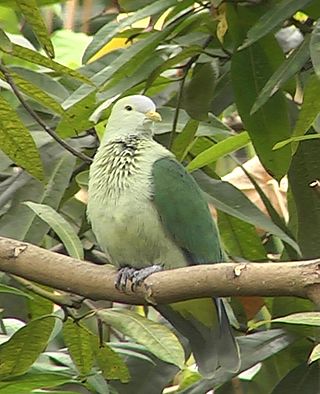
The jambu fruit dove is a smallish colourful fruit dove. It is a resident breeding species in southern Thailand, Malaysia, Brunei and the Indonesian islands of Kalimantan, Sumatra and Java. It is a monotypic species.

The wompoo fruit dove, also known as wompoo pigeon and "magnificent fruit dove" among others, is one of the larger fruit doves native to New Guinea and eastern Australia.

Wallace's fruit dove is a species of a bird in the pigeon family Columbidae. The name commemorates the British naturalist Alfred Russel Wallace. It is a rather large, long-tailed fruit dove with a length of 24–28 cm (9.4–11.0 in) and has been described as "one of the most beautiful" fruit doves. The forehead and crown are dull crimson, the lower face and throat are white, and the rest of the head, breast, neck, and upper back are pale bluish-grey. The wings and lower back are green and the belly is orange, separated from the chest by a white band. Both sexes look similar, but females have less extensive red on the head and a greenish tinge to their grey parts.

The golden dove, also known as the golden fruit dove, lemon dove or yellow dove, is a small, approximately 20 cm (8 in) long, short-tailed fruit-dove in the family Columbidae. The common name refers to the males' bright golden-yellow colour. The body feathers appear almost iridescent due to their elongated shape and hair-like texture. The head is slightly duller with a greenish tinge. The bill, orbital skin and legs are bluish-green and the iris is whitish. The underwings and tail coverts are yellow. The female is a dark green bird with bare parts resembling those of the male. The young resembles the female.

Ducula is a genus of the pigeon family Columbidae, collectively known as imperial pigeons. They are large to very large pigeons with a heavy build and medium to long tails. They are arboreal, feed mainly on fruit and are closely related to the other genus of fruit-eating doves, Ptilinopus. Both genera display brightly coloured plumage, predominantly green, often with contrasting under-parts of purple, orange or red. Some Ducula have prominently swollen ceres. They have large gapes and swallow seeds whole, playing an important role in seed dispersal.

The scarlet-breasted fruit dove is a species of bird in the family Columbidae. It is endemic to Indonesia, where it occurs in the northern Moluccas. Its natural habitat is subtropical or tropical moist lowland forests. It is rated as a species of least concern on the International Union for Conservation of Nature Red List of Endangered Species. In 1863 Hermann Schlegel named the new species for one of his collectors, Heinrich Agathon Bernstein.

The Makatea fruit dove is a species of bird in the family Columbidae. It is endemic to French Polynesia island of Makatea in the Tuamotu Archipelago. Its natural habitat is subtropical or tropical moist lowland forests and is also present near villages. This bird is approximately 20 cm tall and has plumage of mostly green feathers with a dark purple crown and forehead, pale greenish-grey throat and chest, cloven lower chest feathers producing rows of shadows that appear as streaks, yellow underparts, tinged orange anteriorly. The bird's wing feathers are edged yellow. While it continues to be threatened by habitat loss, a decrease in mining since the mid 1960s has helped re-vegetation and appears to have stabilized population numbers.

The atoll fruit dove is a species of bird in the family Columbidae. It is endemic to the Tuamotu archipelago in French Polynesia. Its natural habitats are subtropical or tropical moist lowland forests and plantations. It is threatened by habitat loss.

The coroneted fruit dove, also known as the lilac-capped fruit dove, is a species of bird in the family Columbidae. It is found in New Guinea. Its natural habitats are subtropical or tropical dry forests and subtropical or tropical moist lowland forests, particularly in hilly terrain. The bird is characterised by a distinctive crest or "coronet" of feathers on its head and has a distinctive, low-pitched call. The Coroneted Fruit Dove is a brightly coloured bird with a green head, neck and breast, and a yellow belly.

The red-naped fruit dove is a species of bird in the family Columbidae. It is endemic to Sumba.

The white-capped fruit dove, also called kuku locally, is a species of bird in the family Columbidae. It was described by French naturalist and surgeon Adolphe-Simon Neboux in 1840. It is endemic to the Marquesas Islands in French Polynesia. The name honours French admiral and botanist Abel Aubert du Petit-Thouars. Two subspecies exist on the islands, Ptilinopus d. dupetithouarsii and Ptilinopus d. viridior.

The white-headed fruit dove is a species of bird in the pigeon family Columbidae. It was described by the English ornithologist John Gould in 1856, and the specific name eugeniae honours the French empress Eugénie de Montijo. Adults of the species have white heads, a purplish-red breast patch, a grey shoulder patch, olive-green upperparts, greenish underparts with a blue tinge, and a yellowish vent. Juveniles have green heads with the white restricted to the forehead and upper throat, a much smaller grey shoulder patch, and the red breast patch restricted to the centre of the breast.
The Henderson fruit dove, Henderson Island fruit dove or scarlet-capped fruit dove is a species of bird in the family Columbidae.

The ornate fruit dove is a species of bird in the family Columbidae. It is found in New Guinea. Its natural habitats are subtropical or tropical moist lowland forest and subtropical or tropical moist montane forest.

The pink-spotted fruit dove is a species of bird in the family Columbidae. It is found in forest and woodland in lowland and foothills of New Guinea and nearby smaller islands. It is widespread and generally common.

The crimson-crowned fruit dove, also the Tongan fruit dove or purple-capped fruit dove, is a species of bird in the family Columbidae. It is found in American Samoa, Fiji, Marshall Islands, Niue, Samoa, Tonga, and Wallis and Futuna Islands. Its natural habitats are subtropical or tropical moist lowland forest and subtropical or tropical mangrove forest.

The grey-green fruit dove is a species of bird in the family Columbidae. It is endemic to the Society Islands in French Polynesia. Its natural habitat is subtropical or tropical moist lowland forests.

The white-bibbed fruit dove is a species of bird in the family Columbidae.

The purple-capped fruit dove or Pohnpei fruit dove, is a species of bird in the family Columbidae found on Chuuk and Pohnpei in the Caroline Islands. It was formerly considered as a subspecies of the crimson-crowned fruit dove. Its natural habitats are subtropical or tropical moist lowland forests and subtropical or tropical mangrove forests.

The fruit doves, also known as fruit pigeons, are a genus (Ptilinopus) of birds in the pigeon and dove family (Columbidae). These colourful, frugivorous doves are found in forests and woodlands in Southeast Asia and Oceania. It is a large genus with over 50 species, some threatened or already extinct.




















